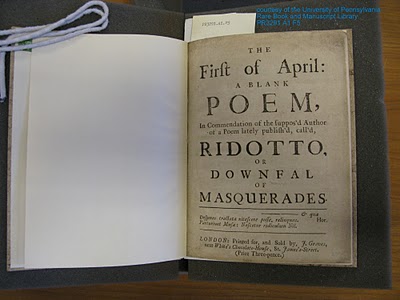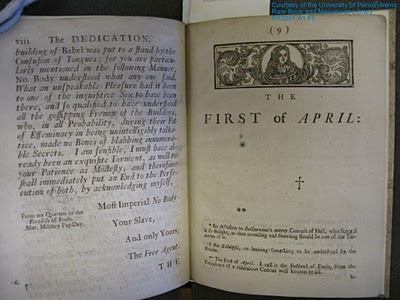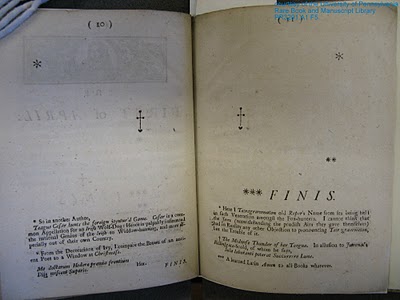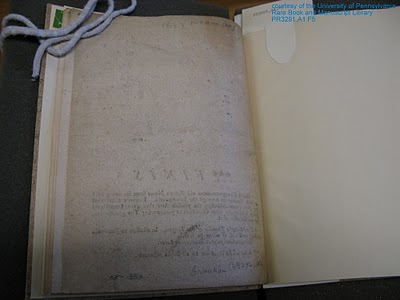A while back, Whitney Trettien posted about a reference she’d come across to an intriguing book called “The First of April: a blank poem in commendation of the suppos’d author of a poem lately publish’d, call’d Ridotto, or, Downfal of masquerades.” Whitney wasn’t able to see the work itself–the ESTC record lists copies only at NYU and Penn–but when I was up in Philadelphia last month, I stopped in at the University of Pennsylvania’s Rare Books and Manuscripts Library to take a look.
It is, as Whitney indicates, a curious thing. What makes it curious is that this is a “blank poem” that is not blank in the sense of “blank verse”, which is the way in which Richard Steere’s 1713 work uses the phrase:
Rather, “The First of April” (probably published around 1724) is blank in the sense that the pages are blank: as Foxon notes, “The poem is indeed blank; all that is printed is a dedication to ‘No Body’ on pp.iii-viii, and footnotes on pp.9-11.”
Here are some shots of what the book looks like. At the top of my post is a shot of the title page; that is followed by six pages of a dedication “To No Body” and signed “The Free Agent.” Facing the last page of the dedication is the first page of the Poem:
That’s a bit blurry, but you can see the layout of the page: a woodcut and title, with footnotes indicated in the otherwise blank body, and provided at the bottom of the page. Here’s a clearer picture of the footnotes to the first page of the blank poem:
The next page opening, with the second and third (and last) pages of the poem:
Again, an enlargement of the notes:
There are some funny jokes in here. “Finis” as “A learned Latin Amen to all Books whatever” isn’t bad. I like the joke about Tetragrammaton, not so much the part about it being hard to pronounce, and that’s why Jews don’t say G-d’s name, but the fact that this blank poem refers to the impossibility of writing and the gap between how something is written and how it is pronounced.
Blankness is clearly central to this poem, and Whitney pulls out some of the connotations of that blankness perfectly:
So what is this “queer little book” doing? Paper was still expensive around this time, we’re told. It would have made up the bulk of any printer’s expenses in producing a book. Studies in marginalia, like Will Sherman’s Used Books, show how earlier Renaissance readers often exploited the blank paper in books as writing pads; and why paper-intensive projects, like John Foxe’s commonplace book of 1,200 all-but-blank pages, were such a risk for printers. (Foxe’s commonplace book failed, the unsold sheets recycled to print two later texts — take a look at Sherman’s discussion around page 138 of Used Books). Although produced over a century later, this blank poem still seems a “waste” economically, especially for an April Fool’s joke.
And clearly “blankness” isn’t being theorized the way it is in, say, Mallarmé. Here, the “First of April” is the blank — the Ridotto it “commends” is the blank — in short, blankness is sarcasm; it signifies the nothingness and “No Body” of what it’s supposed to celebrate. It’s a conceptual poem that exploits its medium, but doesn’t, it seem, rise to the level of a “poetics of blankness.” Which is probably why I’m drawn to it. It’s absence isn’t theorized presence, but stands for simply absence itself. A No Thing ironically made known through the very “thingness” — the necessary “thingness” — of itself.
I think she’s right in that there is something very material about the blankness of this poem. The footnotes highlight that in part, calling attention to the missing poem that is and is not at the center of “First of April.” But there’s another blank in this pamphlet that I find more compelling, one that Whitney didn’t get to see because, as she concludes, for her the poem’s blankness works in a literal way:
Of course, all this is written about a poem I’ve never seen firsthand — whose existence to me is no more than a constellation of bibliographical citations. In other words, the blank poem is blank to me, blank to scholarship, blank to all but the very few who have left traces of its presence in their own work. Difficult to reproduce and impossible to anthologize, the very absence of text makes its material presence necessary, since its physical form bears the weight of signification.
But since I happened to be heading to Philadelphia and since I like to go to rare book libraries, this book is a little less, and a little more blank for me. Look at the final page:








>Great posts, both yours and Whitney Trettien's! This item isn't in ECCO–rather fitting, really, given ECCO's lamentable treatment of blank pages generally…
>Thanks for looking that up, Ian. Now I wish I'd taken better pictures–but maybe someone at Penn or NYU will want to digitize their copies!
>I had read Whitney's original post — so glad to see images of the blank poem!All of this (intriguing) talk about blankness makes me think more about different editorial policies regarding the reproduction of blank pages and margins. The William Blake Archive, for example (where I'm a project assistant), typically crops the images of pages, and in an upcoming publication of one of Blake's manuscripts, chose to not reproduce the blank leaves towards the end of the MS or the blank versos of several pages. Now I'm wondering what we're missing in making those choices!
>Sarah, you are awesome. This is *wonderful*. Thanks so much for snapping the pictures of this curious little artifact, & for continuing the conversation.
>Thanks for posting these images. I too have been following the conversation around this book. This same approach, a poem without a body but with footnotes, is used by the contemporary writer Jenny Boully in her book *The Body: An Essay* published by Essay Press (2007). (See: http://www.essaypress.org/books_authors_jboully.html ) Interesting to see that this method is nearly 300 years old. Somewhat similarly Boully's book *The Book of Beginnings and Endings* is an anthology of sorts of novels, stories, essays, etc. without their middles.
.@mollyhardy Teased something out of the back of my brain: @wynkenhimself http://t.co/nr4t73RYU3 & @whitneytrettien http://t.co/V47Uje1lte
An April Fools’ poem from 1724 courtesy @wynkenhimself http://t.co/SUAkzqF9kK